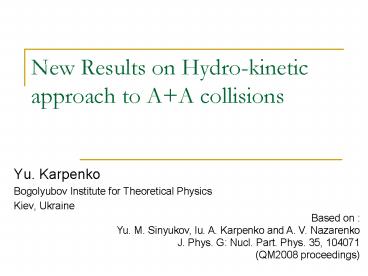New Results on Hydrokinetic approach to A A collisions - PowerPoint PPT Presentation
1 / 19
Title:
New Results on Hydrokinetic approach to A A collisions
Description:
Kiev, Ukraine. Based on : Yu. M. Sinyukov, Iu. A. Karpenko and A. V. Nazarenko. J. Phys. ... The fireball has finite lifetime and spatial dimensions ... – PowerPoint PPT presentation
Number of Views:32
Avg rating:3.0/5.0
Title: New Results on Hydrokinetic approach to A A collisions
1
New Results on Hydro-kinetic approach to AA
collisions
- Yu. Karpenko
- Bogolyubov Institute for Theoretical Physics
- Kiev, Ukraine
Based on Yu. M. Sinyukov, Iu. A. Karpenko and
A. V. Nazarenko J. Phys. G Nucl. Part. Phys. 35,
104071 (QM2008 proceedings)
2
The experiment RHIC collider
hexagonally shaped 3.8 km long storage
rings 1,740 superconducting magnets sqrt(s) 200
A GeV (AuAu)
3
AA collisionsschematic view
time
Initial stage (hard processes)
Thermalization, 1 fm/c
Thermal freeze-out, 10-15 fm/c
Hadronization, 7-8 fm/c
QGP evolution
Before the collision
4
Hydrodynamic approach
- Energy-momentum conservation
- Ideal fluid
- implies local thermodynamic equilibrium
- Needs Equation of State (EoS) to close the set of
hydro equations.
5
Kinetic stage
- The fireball has finite lifetime and spatial
dimensions - Connecting hydrodynamics with kinetic stage is
hard to implement. - Cooper-Frye prescription sudden system decay
6
Hydro-kinetic approach
- The Boltzmann equation (-kinetic) is considered
for the deviations (even strong) from the local
equilibrium (hydro-) - Based on relaxation time approximation and
particle escape probability evaluation - Accounts for conservation laws (-hydro) at the
particle emission
Provides earlier (as compared to Cooper-Frye
prescription) but protracted emission of hadrons,
because escape probability accounts for whole
particle trajectory in rapidly expanding
surrounding (no mean-free path criterion for
freeze-out)
7
Hydro-kinetic approach
Boltzmann equation
are G(ain), L(oss) terms for i-th particle species
and
Relaxation time approximation
Then
gain term
loss term
increases in time
is related to local rest system where collective
velocity
8
Collision rate for pions in Hydro-kinetic
- We account for pion cross sections with 359
hadron and resonance species with masses lt 2.6
GeV. It is supposed that gas is in chemical
equilibrium at Tch 165 MeV. The decay of
resonances into expanding hadronic matter is
taken into account. - The standard Breit-Wigner formula with
energy-dependent widths is used in the same way
as in uRQMD
9
Escape probability
The probability for particle of i-th sort to be
emitted from the hot and dense medim (escape
probability)
10
Emission function in Hydro-kinetic
is the total collision rate of the pion, carrying
momentum p with all the hadrons h in the system
in a vicinity of point x.
is the space-time density of pion production
caused by gradual decays during hydrodynamic
evolution of all the suitable resonances H
including cascade decays. The compositon of the
system is evaluated at each space-time point x
due to resonance decays in accordance with the
width of each resonance and its world line in
Minkowski space.
11
Initial conditionsfor hydro-kientic evolution
- Free streaming of partons from
(formation time for gluons with
well-defined energy) - Sudden thermalization of parton system at
with the pressure, corresponding
to LatticeQCD results - Energy density profile at the thermalization
- (Gaussian fit)
- Initial transverse velocities(developed already
at pre-thermal stage)
? Yu.M. Sinyukov, Acta Phys. Polon. B37, 2006
12
Equation of statefor hydrodynamics
is taken from the latest results of particle
number ratios analysis (F. Becattini,Plenary talk
at QM-2008).
EoS from LattQCD (in form proposed by Laine
Schroder, Phys. Rev. D73, 2006)
QGP phase
crossover PT
The EoS accounts for gradual decays of the
resonances during the expansion of hadron gas
consistiong of 359 particle species with masses
below 2.6 GeV. We evaluate the change of the
compositon of the system at each space-time point
x due to resonance decays in accordance with the
width of each resonance and its world line in
Minkowski space.
hadron phase
13
Numerical hydrodynamics
- Finite-volume method with relativistic HLLE
(HartenLaxvan LeerEinfeldt) solver, based on
approximate handling of the Riemann problem by
introduction of an intermediate state and two
waves propagating with some signal velocities. - Linear distributions of conservative variables in
a cell to achieve second order of accuracy in
space - Predictor-corrector scheme to achieve second
order of accuracy in time
Written (as well as the other parts of the code)
in C
14
RESULTS Pion emission density for RHIC energies
in HKM
Proper time
Transverse radius
15
Results Pion emission at different pT
x-p correlation is present high-pT particles
are emitted from the periphery (large x), and
vice-versa
16
Pion pT spectrum vs RHIC 200 A GeV data
17
The idea of interferometry measurements
Gaussian approximation of CFs (q?0)
Rout, Rside, Rlong reflect space-time
characteristics of emission process
18
HBT-radii vs RHIC 200 A GeV data
The interferometry (or HBT-) radii characterize
the space-time scales of matter evolution in AA
collisions
A reasonable description of RHIC HBT data (PHENIX
STAR), except for overestimate for R_out
19
Conclusions
- The hydrokinetic approach to AA collisions is
proposed. It allows one to describe the
continuous particle emission from a hot and
dense finite system, expanding hydrodynamically
into vacuum, in the way which is consistent with
Boltzmann equations and conservation laws, and
accounts also for the opacity effects. - The approach is extended to account for the
decays of the resonances during the system
evolution - A reasonable description of the pionic spectra
and HBT (except some an overestimate for
) in cental AuAu collisions at the RHIC 200A GeV
energy is reached































